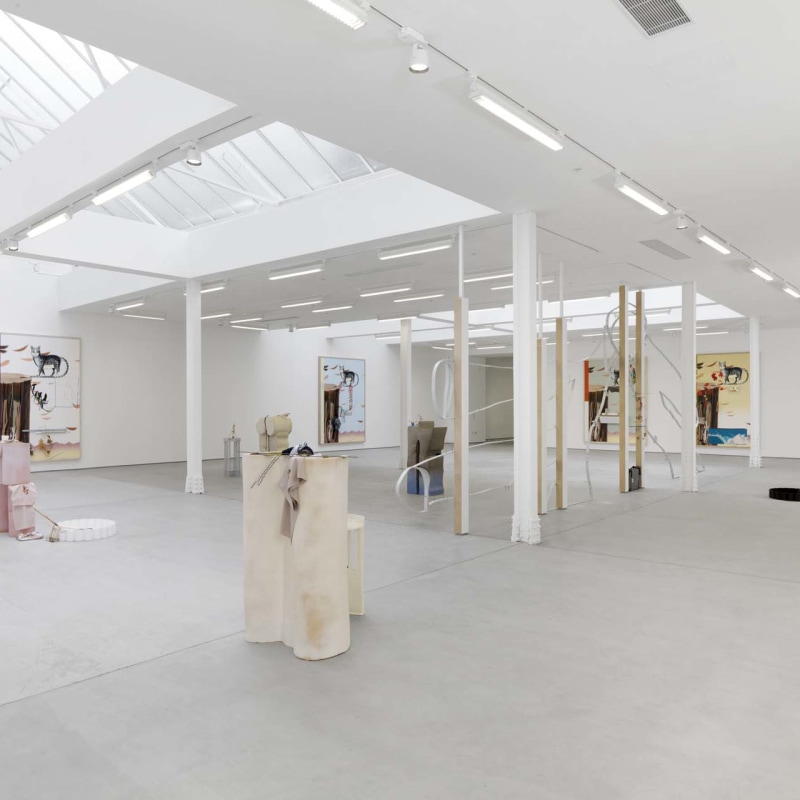Helen Marten’s first exhibition at Sadie Coles HQ, Oreo St. James, brings together an extensive group of new sculptural works revolving around the concept of the model as a basic means of organisation. Shifting continually between two–dimensional and three-dimensional modes, the works seek various methods of repositioning habitual experience, proposing a sensation of intoxication through a deceptive patina of familiarity. The exhibition’s title, like many of the works, is humanised – but at once a pseudonym, brand name, and a biblical or geographic abstraction. In this sense, linguistic grammar games maintain the aura of a singular but somehow alien taxonomy.
Marten’s art is underscored by an interest in the point at which diagrammatic clarity – a recognisable model or paradigm – breaks down, as though wilted through a process of collaged abstraction. Ceramic vessels positioned throughout the gallery hint at figuration from one level removed. Simultaneously architectural and ruinous, their vernacular forms (clothing or skin) are at odds with their unruly materiality. Crassly simplified outlines have been bulbously inflated: like motifs of animation that will never regain the movement of their lines, they are endowed with obstinate volume. As elemental building blocks – things we might call top, trouser, shoe – they could be described as ancient devices for modesty or obfuscation or convenience, but simultaneously as rigid forms for the display of erotic garments.
The ceramic works thus serve as repositories for elaborate sculptural tableaux whose assembled detritus creates a string of hieroglyphs or a kind of archaeological anagram: encrypted sequences present short bursts of personality and internal logic. Similar in form and function to bundles of votive offerings, these assemblages are charged with metonymic significance (a form analogous with a fire extinguisher houses a tap profile and other suggestions of wetness or liquid; a model church constructed from tooth picks is the literal folly of an architect’s ashtray-discarded reverie). In a chaotic spew of the organic and inorganic, long strings of metaphors dissolve and reformulate. Marten’s works are, in this way, vehicles for gathering a kind of sociological dust. Just as her assemblages seem to risk becoming too fantastical, they are abruptly grounded by (for instance) the obstinate dullness of a polo mint. Marten’s art refuses us the satisfaction of a resolving punch line, remaining neurotically rooted in surface and sensory momentum.
In eight screen-printed paintings on leather, Marten again lays bare the potency of line to read as an image: basic linear marks convey information at speed (a cat with an arabesque tail; a schematic front door), and yet the logic of these components – loosely amalgamated and printed on a monumental scale – appears to have shifted. The cat, an emblem of placid domesticity, is poised ambivalently between the status of pictogram, cartoon and decorative conceit. Depicted walking off a cliff, this repeated motif is literally a suspended animation, another instance of a figurative outline that is denied its mobile potential. Multiple vistas are overlaid (both paint and image) to suggest endless permutations of a recurring thought. The works are, in this regard, emphatically analogue. Extending Marten’s preoccupation with imagistic psychedelics, these works mirror the non-sequiturs or taboos of dream sequences, giving space to the nonsensical possibilities located on the threshold of retinal certainty. Contrasting with the weightless, immaterial images printed across the leather surface, an array of sculptural parasites form a disruptive and tactile invitation into each picture.
Collectively, Marten’s works are foils, rebus, supplementary forms or degraded representations of themselves: potpourri, latex and grass stalks are both their material selves, but also imagistic stand-ins for some other more coded possibility.
Helen Marten (born 1985, Macclesfield) lives and w orks in London. Recent solo exhibitions include No borders in a wok that can’t be crossed, CCS Bard Hessel Museum, Annandale-on-Hudson (NY), USA (2013); Plank Salad, Chisenhale Gallery, London (2012); Evian Disease, Palais de Tokyo, Paris (2012); Almost the Exact Shape of Florida, Kunsthalle Zürich, Zürich, Sw itzerland; Dust and Piranhas, ‘Park Nights’, Serpentine Gallery (2011); Take a stick and make it sharp, Johann König, Berlin (2011) and Wicked Patterns, T293, Naples (2010). Major group exhibitions include Il Palazzo Enciclopedico (The Encyclopedic Palace), 55th International Art Exhibition, Venice Biennale, Venice, Italy (2013); 12th Lyon Biennale, Lyon (2013); New pictures of common objects, MoMA PS1, New York (2012); and The New Public, Museion, Bolzano (2012). Marten received the Lafayette Prize in 2011 and the LUMA Aw ard in 2012. In 2013, a monograph on the artist w as published by JRP|Ringier in conjunction w ith her exhibitions at CCS Bard Hessel Museum, the Chisenhale Gallery and Kunsthalle Zürich.
With special thanks to Beatrix Ruf
For further information please contact the gallery at +44 (0)20 7493 8611 or press@sadiecoles.com
